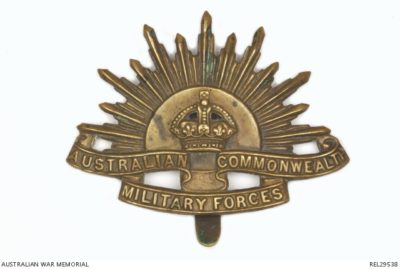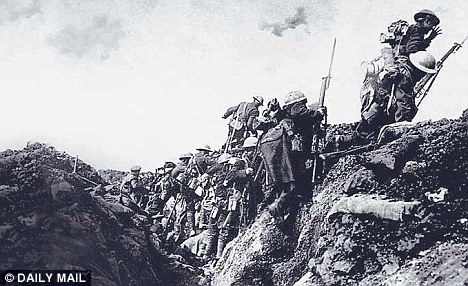This week marks 100 years since the World War I battles of Fromelles and Pozieres — two of the deadliest and most gruesome in Australia’s military history.
Our decent honourable ordinary Australian men, trusting, signed up, trained, deployed and then were ordered by Government Army officers to go over the top and run doomed into dozens of waiting enemy machine gun posts like this.
PM William Morris Hughes ought have led from the front the bastard, rather than resiling to become Australia’s worst bloody mass murderer.
5533 Aussie men got slaughtered.
This futility of a foreign war was not of our making nor choosing. We honour their death by insisting the democratic right of Australian independence in world affairs.
“They shall grow not old, as we that are left grow old;
Age shall not weary them, nor the years condemn.
At the going down of the sun and in the morning
We will remember them.”
Lest We Forget.
Battle of Fromelles according to the reliable Australian War Memorial
https://www.awm.gov.au/military-event/E159/
“Fromelles was the first major battle fought by Australian troops on the Western Front. Directed against a strong German position known as the Sugar Loaf salient, the attack was intended primarily as a feint to draw German troops away from the Somme offensive then being pursued further to the south.
A seven-hour preparatory bombardment deprived the attack of any hope of surprise, and ultimately proved ineffective in subduing the well-entrenched defenders.
When the troops of the 5th Australian and 61st British Divisions attacked at 6 pm on 19 July 1916, they suffered heavily at the hands of German machine-gunners. Small parts of the German trenches were captured by the 8th and 14th Australian Brigades, but, devoid of flanking support and subjected to fierce counter-attacks, they were forced to withdraw.
By 8am on 20 July 1916, the battle was over. The 5th Australian Division suffered 5,533 casualties, rendering it incapable of offensive action for many months; the 61st British Division suffered 1,547. The German casualties were little more than 1,000. The attack was a complete failure as the Germans realised within a few hours it was merely a feint. It therefore had no impact whatsoever upon the progress of the Somme offensive.”
Wartime Issue 36 – Disaster at Fromelles
https://www.awm.gov.au/wartime/36/article/
“The worst 24 hours in Australian history occurred 90 years ago at Fromelles. Not the worst in Australian military history, the worst 24 hours in Australia’s entire history. The Australians suffered 5,533 casualties in one night. The Australian toll at Fromelles was equivalent to the total Australian casualties in the Boer War, Korean War and Vietnam War put together. It was a staggering disaster.
And this catastrophic attack at Fromelles – advocated and orchestrated by a British corps commander – had no redeeming tactical justification whatsoever. It was, in the words of a senior participant, Brigadier General H.E. “Pompey” Elliott, a “tactical abortion”. One-third of the Australian casualties at Fromelles were in Elliott’s 15th Brigade.
In July 1916 Elliott and his men had just arrived at the Western Front. Like most formations new to the main arena in the biggest war there had ever been, they were given a relatively undemanding initiation in a quiet part of the line. Only twice since the Western Front had stabilised had there been fierce fighting in this benign sector near Fromelles. But Elliott and his senior officers had scarcely begun to familiarise themselves with their new surroundings when they received startling news: Elliott’s 15th Brigade would be participating in the 5th Division’s imminent full-scale attack against the Germans.
Elliott was profoundly concerned. The operation seemed inadvisable for a host of reasons: preparations would be rushed, the artillery was inexperienced, and no man’s land was too wide (400 metres in places). Elliott’s men would also have to advance opposite the formidable German strongpoint known as the Sugarloaf, an elevated concrete bastion bristling with machine-guns.
With Elliott’s misgivings growing, he met Major H.C.L. Howard, a visiting staff officer from the Commander-in-Chief’s headquarters. Elliott took Howard forward, not just to the front line but beyond, to a post in no man’s land that afforded a good view of the Sugarloaf. Elliott showed
Howard his planned dispositions and draft orders and asked for Howard’s frank assessment of what would eventuate. Visibly moved, Howard predicted the attack would prove “a bloody holocaust”.
Elliott urged him to go back to Sir Douglas Haig and say so. Howard promised he would.
Whatever Howard may have said to Haig, the attack was delayed but not cancelled. The attack was fixed for 19 July.
Disaster loomed with terrible inevitability.
The preparations were rushed and inadequate. Moreover, the Germans on higher ground enjoyed sweeping visibility and could see what was happening. Crucially, the attackers’ inexperienced artillery units did not achieve their objectives in the preparatory bombardment. In particular, they failed to deal with the Germans’ lethal Sugarloaf machine-guns. Afterwards, a senior artillery commander complained that he had been severely handicapped. It was not just that he was given insufficient time to familiarise himself with the battlefield and register his batteries properly. He was allotted hardly any support staff and ended up without even a decent map to make sense of the messages he received during the battle.
The unsubdued Sugarloaf machine-guns inflicted calamitous casualties on the 15th Brigade. Its attacking battalions, the 59th and 60th, were practically wiped out. On the scene was W.H. “Jimmy” Downing, who served in Elliott’s brigade during the war and became his legal partner after it. He recorded his impressions:
Stammering scores of German machine-guns spluttered violently, drowning the noise of the cannonade. The air was thick with bullets, swishing in a flat criss-crossed lattice of death … Hundreds were mown down in the flicker of an eyelid, like great rows of teeth knocked from a comb … Men were cut in two by streams of bullets [that] swept like whirling knives … It was the charge of the Light Brigade once more, but more terrible, more hopeless.
The 59th and 60th Battalions advanced in four waves five minutes apart. Each line surged forward to be cut down in its turn. Lieutenant Tom Kerr, ascending the parapet as part of the third wave, expected to see the previous lines pressing forward ahead of him, but there was no movement at all. He could see plenty of Australians, but all were lying still.
Major Geoff McCrae, the 60th commander, went forward in the fourth wave accompanied by telephone equipment. After a while, when General Elliott had failed to hear from the 60th, he directed his intelligence officer, 22-year-old Lieutenant Dave Doyle, to get in touch with McCrae. Doyle ventured into no man’s land and found himself a target of such exceptionally heavy machine-gun fire that he regarded his survival as miraculous.
He did not find McCrae.
Like hundreds of his men, McCrae was already dead. Of all the forces engaged in the war, few battalions, if any, accumulated more casualties more rapidly than did the 60th at Fromelles. Moreover, an unusually high proportion of the casualties were killed. Kerr, still in shock after losing so many friends and collecting wounds himself, was amazed to find himself acting commander of a battalion that had almost disappeared.
As stricken Australians in no man’s land writhed in agony, shocked observers of the aftermath struggled for words. “Most awful scene of slaughter imaginable” noted Doyle. Witnesses likened the 15th Brigade’s devastated trenches to butchers’ premises: “If you had gathered the stock of a thousand butcher-shops, cut it into small pieces and strewn it about, it would give you a faint conception of the shambles those trenches were,” wrote a 59th Battalion corporal, Hugh Knyvett.
Ordinary sandbagged trenches were now heaps of debris, and it was impossible to walk far without falling over dead men, [but] Pompey went from battalion to company headquarters and so on right along the line. A word for a wounded man here, a pat of approbation to a bleary-eyed digger there, he missed nobody. He never spoke a word all the way back to advanced brigade [headquarters] but went straight inside, put his head in his hands, and sobbed his heart out.
Afterwards Elliott greeted shocked survivors as they returned. Decades later, Lieutenant Neil Freeman remembered seeing Elliott “with tears streaming down his face”; as he shook hands with the “pitiful remnant of his brigade”. Other survivors were struck by the intensity of his anguish. At one stage Elliott called out to Captain Bill Trainor, “Good God Bill, what’s happened to my brigade?”
The ghastliness of Fromelles seared Elliott’s soul. More than 1,800 officers and men in the 15th Brigade obeyed orders, did their best, and became casualties in a catastrophe that Elliott had predicted and tried to prevent. And it was quality as well as quantity: among the officers killed was Major Tom Elliott (no relation), a Duntroon graduate of such outstanding promise that Pompey Elliott had tried – unsuccessfully – to keep him out of the battle because he regarded him as a potential “Australian Kitchener”.
Furthermore, of all the thousands of casualties in units under Elliott’s command, none tormented him more than the death of McCrae, a talented and popular officer who had served under Elliott at Gallipoli and in the pre-war militia. “If I myself should fall in France,” Elliott later wrote, “; I should like to be buried near poor Geoff.” Elliott survived the war, but his death in 1931 was a war-related suicide. His sad demise had a great deal to do with the disaster of Fromelles.”






